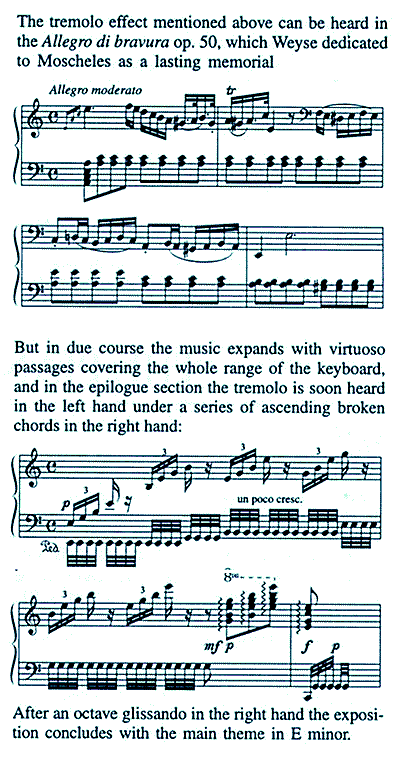This is a re-issue by Marco Polo/Dacapo from the Dacapo
release eight years ago.
Christoph Weyse was born in Denmark, close to
the German border near Hamburg. In his teens he arrived in Copenhagen
as a young virtuoso pianist to live with Schulz, a composer and conductor
of the Royal Theatre there. This introduction to Schulz and the move
had been due to the influence of professor C F Cramer of Kiel who was
the son of the King Frederik Vís court chaplain. The young Weyse had
visited Cramer asking for help to become a musician and the move to
Copenhagen had been the outcome.
Weyseís early years in Copenhagen as apprentice to
Schulz led to his acceptance for the post of organist in the German
Reformed Church (1792) at the age of eighteen. He went on to play at
court, perform piano concertos by Mozart and become a member of one
of the cityís private musical clubs. During the early part of his career
he wrote songs and contemporary testimony indicates that, as a pianist,
his improvisatory talents were extraordinary. In a letter to the music
publisher Härtel in Leipzig, Kuhlau went so far as to say that
Weyse was the best pianist he had ever heard and that he far outshone
Ferdinand Ries, the composer and pupil of Beethoven who was one of the
great virtuosi of the age and was touring Scandinavia at the time.
Weyse's chief contribution to Danish music history
was in the field of vocal composition, which was the dominant genre
in Danish romanticism in the rest of the nineteenth century.
The Piano Works
Weyse was conservative by nature, and his musical horizon
did not extend beyond Mozart (at least in his youth); his contemporary
Beethoven seems not to have made any impression on him at all. He, himself,
says the composers revered were J.S. Bach, Handel, C.P.E. Bach, Haydn,
Mozart, Gluck, and Schulz. When he began to study with Schulz he encountered
Clementi's piano music for the first time. This composer, together with
J.S. and C.P.E. Bach, Haydn, and Mozart can be said to have left the
most significant mark on Weyse's own piano music. Weyse's earliest piano
works are preserved in two autograph volumes entitled "Jugendarbeiten
1790-1794". They consist of a handful of small pieces, fugues, a
fantasy in the style of C.P.E. Bach, four sonatas inspired by Schulz,
Clementi, Haydn, and Mozart, and eight of the virtuoso Allegros in sonata
form that were later to become his speciality. A reviewer wrote at the
time that Weyse was the first to promote this genre under the title
of Allegri di bravura. The German composer, critic, and publisher
Johann Friedrich Reichardt, who visited Copenhagen in 1793, arranged
for six new Allegri di bravura to be printed in Germany in 1796.
These debut compositions were very flatteringly received.
There now followed a period of over twenty years in
which Weyse apparently wrote nothing new for the piano. It needed an
external impulse to stimulate Weyse to new piano-writing activity. In
the autumn of 1829 the Bohemian composer, Ignaz Moscheles, probably
the greatest and most respected piano virtuoso of the time, visited
Copenhagen and took audiences by storm with his playing. There is no
doubt that Moscheles was responsible for reawakening Weyse's interest
in the piano at this late stage in his life, when he produced his last
significant works for the instrument: the big Allegro di bravura
in A minor op. 50 and the twelve Etudes op. 51 and 60.
A remarkable thing is that the conservative Weyse now writes music in
a wholly up-to-date style. Having practised classicism in his youth,
the composer became a romantic in his old age. His Allegro con brio
in E major and the one in F Major from his Op.60 are interesting
and of individualistic style (tk.9 & 11) Running through the etudes
is a noticeable liking for chromatic scales of various descriptions.
The acoustics of the venue (hall name not given) are
flattering and the piano is nicely miked. The detailed notes by an unknown
writer (Carsten Hatting perhaps?) go out of their way to give musical
examples to explain the tremolo effect which Moscheles taught Weyse
for use in his Allegro di bravura. This can be heard (tk.13 at
3.00 and 5.50).
The pianist Bohumila Jedlickova graduated first from
the Prague Conservatoire and later from the city's Academy of Music.
She moved on to Copenhagenís Academy of Music and in 1973 made her debut,
winning the Carl Nielsen Prize which allowed study at the Juilliard
School in New York. The etudes here, sometimes very short, are played
with deep expression, panache and vigour. They are experimental, inventive
studies that are demanding of a pianistís agility but with content that
is not always memorable. Jedlickova meets the challenge of breathing
life into them with energy and commitment.
Raymond Walker


